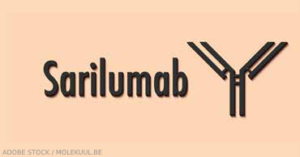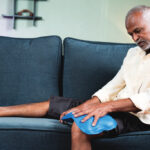 In an ACR Convergence 2022 session, Robert Spiera, MD, director of the Scleroderma, Vasculitis, and Myositis Center at the Hospital for Special Surgery, New York City, discussed the use of sarilumab as a potential glucocorticoid-sparing therapy in a phase 3 study in patients with treatment-refractory polymyalgia rheumatica (PMR), one of the most common inflammatory diseases of the elderly.1,2
In an ACR Convergence 2022 session, Robert Spiera, MD, director of the Scleroderma, Vasculitis, and Myositis Center at the Hospital for Special Surgery, New York City, discussed the use of sarilumab as a potential glucocorticoid-sparing therapy in a phase 3 study in patients with treatment-refractory polymyalgia rheumatica (PMR), one of the most common inflammatory diseases of the elderly.1,2
“Polymyalgia rheumatica is relatively easy to treat with glucocorticoids, but unfortunately relapses are common, resulting in prolonged courses of glucocorticoid therapy with its attendant morbidities,” Dr. Spiera said. “So we have recognized that a steroid-sparing therapy is an unmet need in PMR.”
Dr. Spiera explained that interleukin 6 (IL-6) seems to be a pivotal player in the pathophysiology of PMR. Blood levels of IL-6 are high in untreated patients and often rapidly fall after glucocorticoid treatment is started; concentrations of both plasma IL-6 and soluble IL-6 receptors correlate with disease activity. Moreover, persistent elevations in IL-6 are associated with relapsing, refractory disease, requiring extended treatment with glucocorticoids.3
Two placebo-controlled trials showed a potential benefit for IL-6 inhibition, including a randomized phase 2/3 trial of the IL-6 inhibitor tocilizumab, which showed that it was superior to placebo in terms of rates of remission, time to relapse and cumulative glucocorticoid dose.4,5
SAPHYR Trial Results

Dr. Spiera
Dr. Spiera and his colleagues designed the SAPHYR trial, a randomized, double-blind, placebo-controlled phase 3 study, to assess the efficacy and safety of another IL-6 antagonist, sarilumab, in PMR patients aged 50 or older. Dr. Spiera pointed out that they studied patients who were refractory to steroid treatment, the PMR population with the greatest unmet treatment needs. To be eligible, patients had to have flared within three months of study entry while still on 7.5 mg or greater of prednisone.
Although initially designed for 280 patients, the number of participants recruited was lower due to the timing of the COVID-19 pandemic. The researchers randomized the patients into a treatment group of 200 mg of sarilumab subcutaneously every two weeks (n=59) and a comparator arm receiving placebo every two weeks (n=58). Participants in the treatment group had their steroids tapered rapidly over 14 weeks, compared to a more traditional 52-week taper in the comparator arm.
The study’s primary end point was the proportion of patients in sustained remission at week 52. To meet this end point, patients had to achieve remission by 12 weeks, including complete remission of clinical symptoms and normalization of C-reactive protein (CRP). They also had to have no flares from 12 weeks onward, defined as having no symptoms or elevated erythrocyte sedimentation rate readings necessitating an increased glucocorticoid dose, with CRP levels still in the normal range while adhering to the defined steroid taper.
Dr. Spiera explained that some other studies of IL-6 inhibitors in PMR have used protocols with more rapid glucocorticoid tapers in both arms, whereas they compared sarilumab with a very rapid glucocorticoid taper vs. more traditional glucocorticoid doses in the comparator arm. “I think what we were replicating in the comparator arm was that in the real world, we try to take people off steroids,” he said. “Moreover, I think that is where the unmet need is—these patients who you could leave on steroids for a longer period.”
The study met its primary end point: Of the patients in the sarilumab arm, 28% achieved remission compared to only 10% in the comparator arm (P=0.02); when normalization of CRP was dropped from the definition of sustained remission, 32% of patients on sarilumab achieved it compared to 14% of patients on placebo (P=0.03). This trend continued in analysis of individual components defining remission, including the percentage of patients achieving remission by week 12, when the treatment group was on 2 mg of prednisone vs. approximately 8 mg in the placebo group.
“[The study protocol] had a very high bar for defining remission,” Dr. Spiera said.
These stringent criteria may have played a role in decreasing these remission rates compared to some other existing trials of IL-6 inhibitors in PMR that used more relaxed measures of remission. The rapid glucocorticoid taper may also have decreased remission rates in the treatment group compared with studies that allowed additional glucocorticoids at higher and/or longer doses.
The proportion of patients without any PMR signs and symptoms was also higher in the sarilumab arm compared with placebo, increasing as soon as week 2 and continuing to increase until week 52, with a similar trend observed when excluding patients who required glucocorticoid treatment as rescue therapy. Patients in the sarilumab arm were also less likely to flare after achieving clinical remission (17% vs. 29%; hazard ratio 0.56; P=0.02).
The cumulative corticosteroid dose was also higher in patients in the placebo group. Dr. Spiera pointed out that some of that was due to 52-week taper in this group, but the difference between the anticipated steroid use and actual steroid use, the difference in rescue steroids, was statistically significantly lower in the sarilumab group (P=0.02) A higher proportion of patients in the comparator arm also required additional glucocorticoids as rescue therapy compared to the sarilumab arm (59% vs. 32%; P=0.0053).
A variety of patient-reported quality of life and function measures, including the Short Form-36 Mental Component and Physical Component Scores, the Functional Assessment of Chronic Illness, the EuroQol-5 Dimension (EQ-5D) and the Health Assessment Questionnaire-Disability Index (HAQ-DI), favored sarilumab in a statistically significant manner, as did some of the physician assessments like the PMR-Activity Scale (PMR-AS).
Adverse events were as expected with sarilumab, and the frequency of serious adverse events was similar in both arms. In the sarilumab arm, 15% of patients had neutropenia, and another 15% had arthralgias. The comparator arm had more effects related to glucocorticoids, such as insomnia (16%). Dr. Spiera also pointed out that no patients in the sarilumab group had diverticulitis that required medical intervention from gastrointestinal perforation; this was a potential concern given the older patient age group and this rare potential adverse effect of IL-6 inhibitors.
When asked when he might use sarilumab in clinical practice, Dr. Spiera noted that for a patient not flaring on very low glucocorticoid doses, it might not be needed. “But that’s not the group of patients that’s our challenge,” he added. “I think I’d be interested in giving it to any patient who has previously flared or any patient at very high risk of glucocorticoid side effects.”
Ruth Jessen Hickman, MD, a graduate of the Indiana University School of Medicine, is a medical and science writer in Bloomington, Ind.
References
- Spiera R, Unizony S, Warrington K, et al. Sarilumab in patients with relapsing polymyalgia rheumatica: A phase 3, multicenter, randomized, double blind, placebo controlled trial (SAPHYR) [abstract]. Arthritis Rheumatol. 2022 Nov;74(suppl 9).
- Spiera R, Unizony S, Warrington K, et al. Resolution of PMR signs and symptoms in patients treated with sarilumab: A phase 3, multicenter, randomized, blind, placebo controlled trial (SAPHYR) in relapsing PMR. Arthritis Rheumatol. 2022 Nov;74 (suppl 9).
- Lally L, Forbess L, Hatzis C, et al. Brief report: A prospective open-label phase IIa trial of tocilizumab in the treatment of polymyalgia rheumatica. Arthritis Rheumatol. 2016 Oct;68(10):2550–2554.
- Bonelli M, Radner H, Kerschbaumer A, et al. Tocilizumab in patients with new onset polymyalgia rheumatica (PMR-SPARE): A phase 2/3 randomised controlled trial. Ann Rheum Dis. 2022 Jun;81(6):838–844.
- Devauchelle-Pensec V, Carvajal-Alegria G, Dernis E, et al. Effect of tocilizumab on disease activity in patients with active polymyalgia rheumatica receiving glucocorticoid therapy: A randomized clinical trial. JAMA. 2022 Sep 20;328(11):1053–1062.


